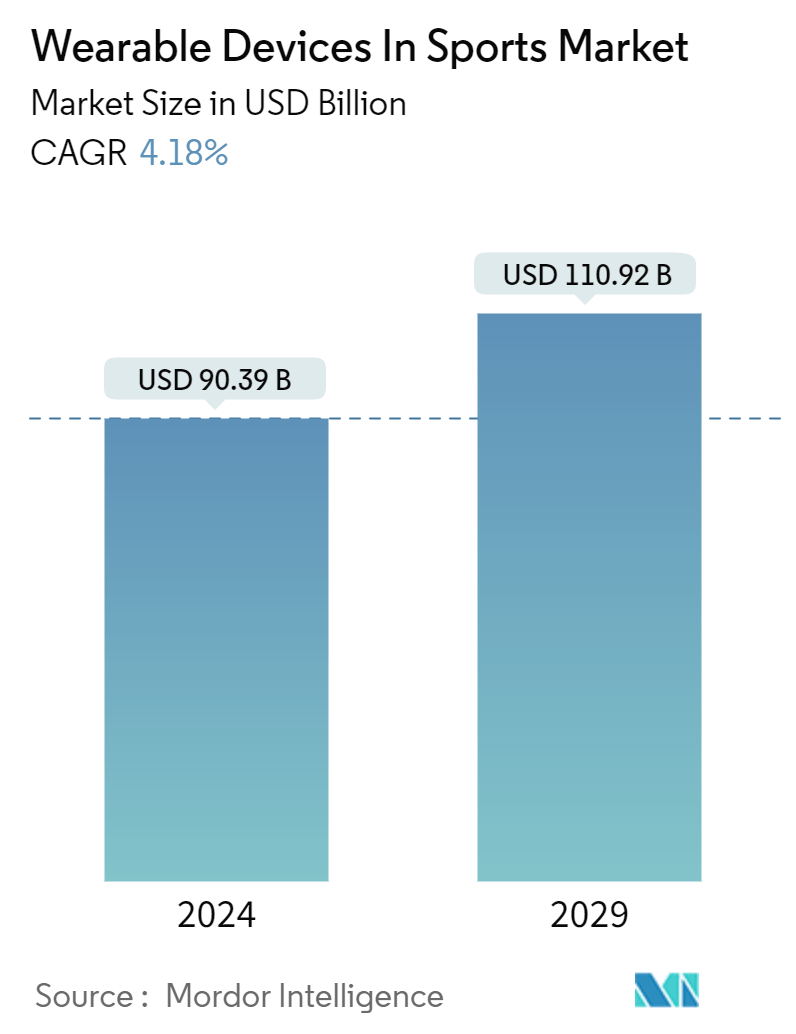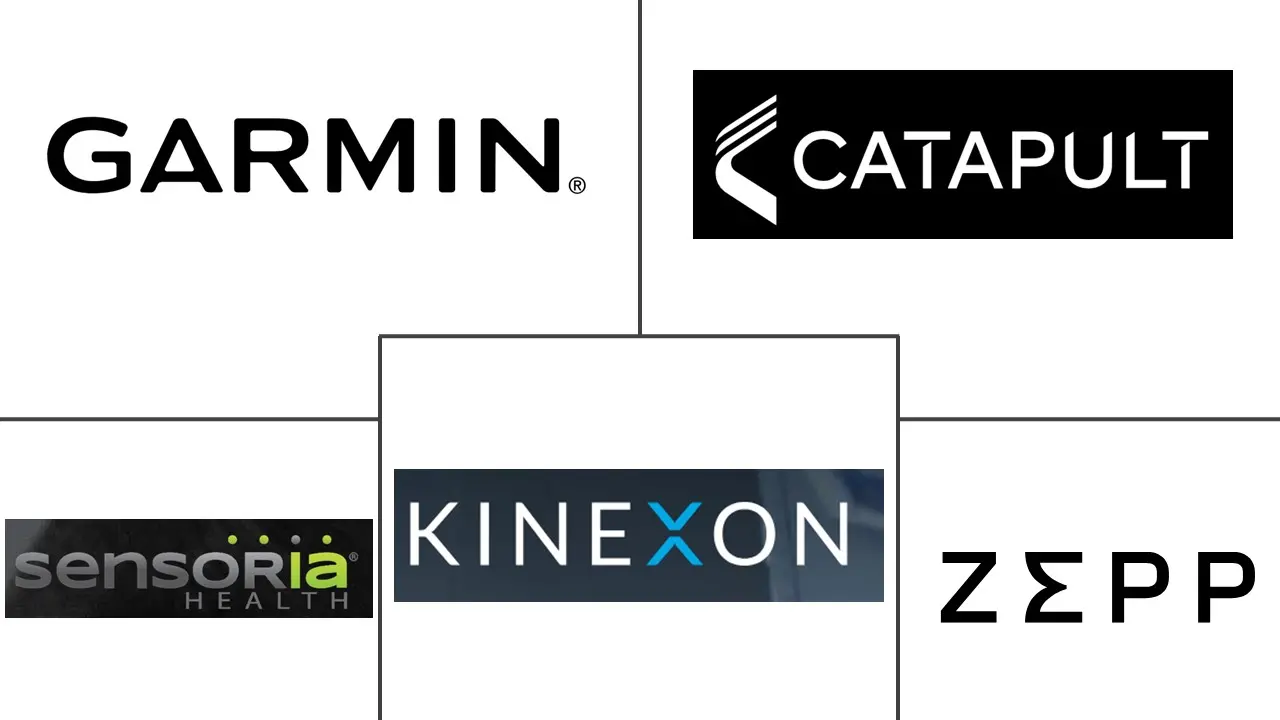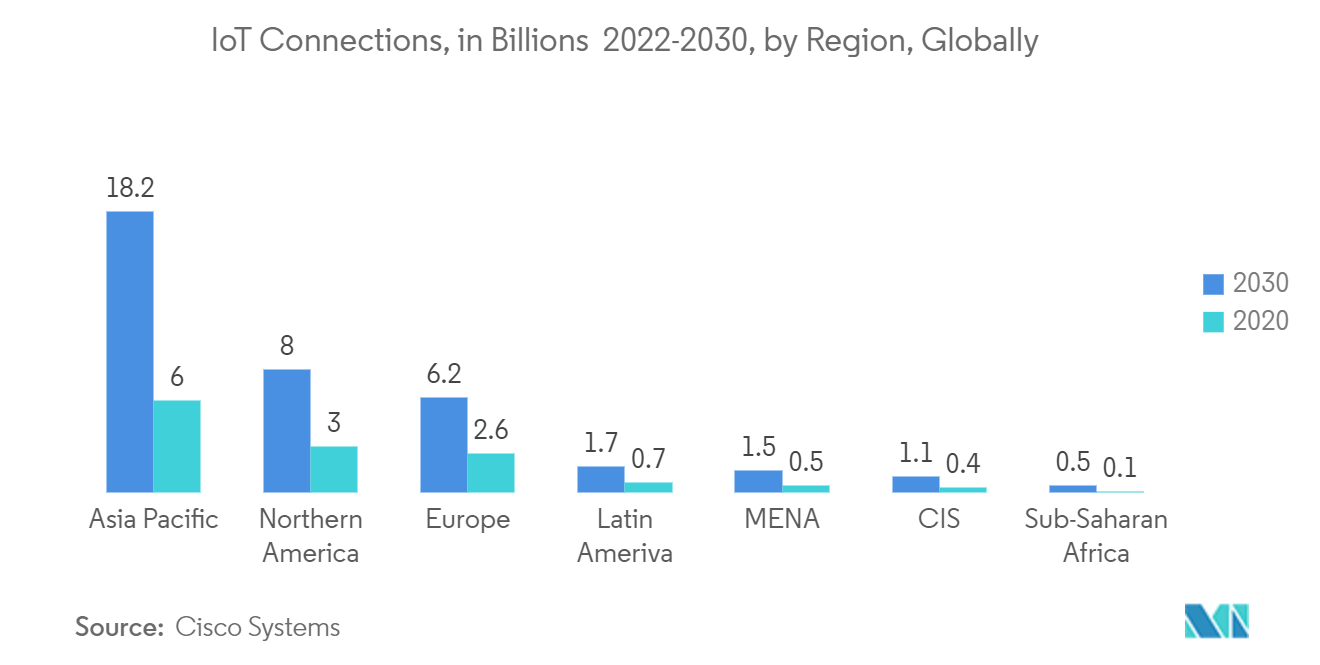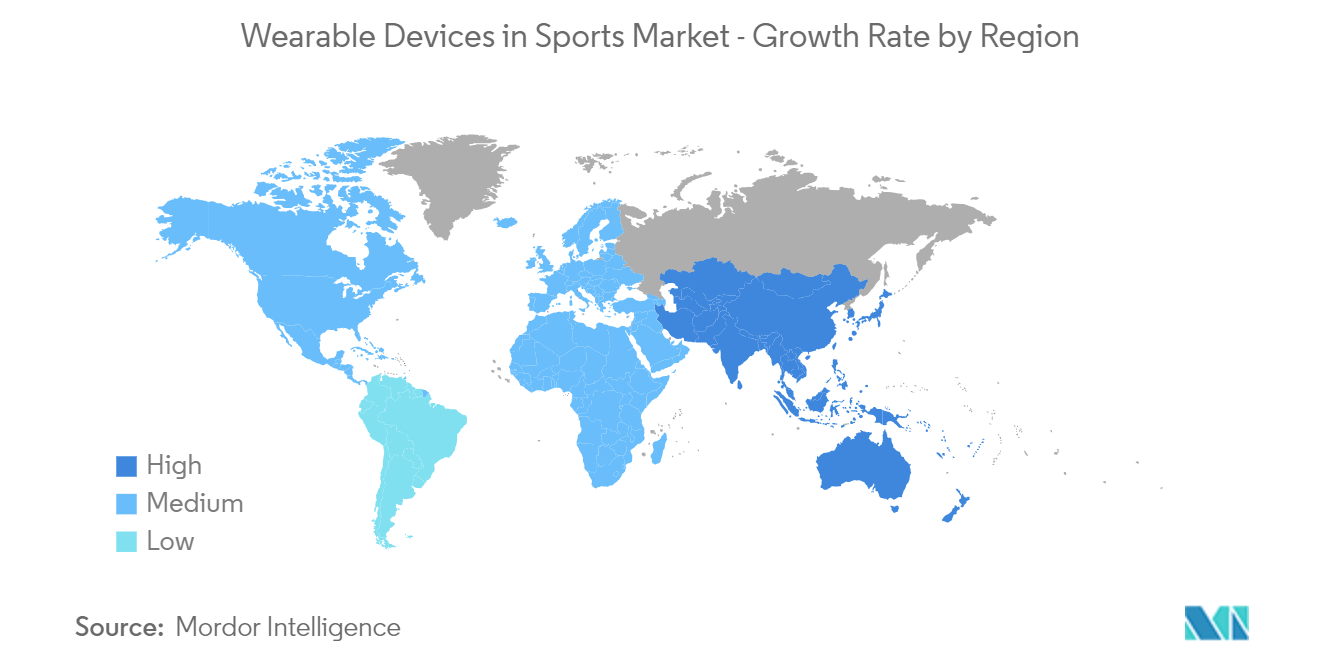Sports Wearable Devices Market Size

| Study Period | 2019 - 2029 |
| Market Size (2024) | USD 90.39 Billion |
| Market Size (2029) | USD 110.92 Billion |
| CAGR (2024 - 2029) | 4.18 % |
| Fastest Growing Market | Asia Pacific |
| Largest Market | North America |
Major Players
*Disclaimer: Major Players sorted in no particular order |
Sports Wearable Devices Market Analysis
The Wearable Devices In Sports Market size is estimated at USD 90.39 billion in 2024, and is expected to reach USD 110.92 billion by 2029, growing at a CAGR of 4.18% during the forecast period (2024-2029).
The wearable technology and devices market is unfolding at a rapid pace. With the industry going towards a focal point, businesses are prioritizing service enhancement, apart from adding additional new features to the device itself.
- Wearable devices have remained a significant part of the sports industry, supporting the athlete to stick to daily routines and giving important information on various parameters it is programmed to control. Integration of analytics tools for better evaluating and analyzing this data to improve the performance or handling of overall personal fitness has sustained the need for wearable devices in the sports industry.
- The growth in the wearables market can be attributed to increasing demand coupled with the propagation and suitability of improved communications protocol and miniaturization of sensor technology. Sensors and wearable devices can be combined into multiple accessories such as wristwear, garments, shoes, and eyeglasses because of their compressed or compact size and superior integration technologies.
- The factors influencing wearable devices in the sports market include the entry of big players, portable and comfortable usage, elevated healthcare awareness, the soaring cost of manufacturing, and technological progressions. These essential factors have encouraged the adoption of wearable devices. Wearable devices such as activity trackers, smartwatches, and smart clothing are preferred among customers owing to their numerous advantages, including portable usage and the most modern and advanced technological advancements.
- The increasing number of sports events, both online and offline, has indeed been a significant driver for the wearable devices market in sports. The rise in sports events, including professional competitions, amateur tournaments, and community-driven activities, has created a demand for wearable devices to enhance the sports experience, provide real-time data, and track performance metrics.
- Wearable electronic devices find various applications in fitness and sports for controlling and monitoring parameters such as heart rate, calorie consumption, sleep, and blood pressure. Wearable devices permit a user to check health-related information on their smart wearables.
- One of the main obstacles anticipated to restrain the market's expansion during the forecast period is the high cost of innovative wearable technology. Most firms in this sector are releasing their products under the category of premium products, which are not affordable for many users and restrict the products from reaching economies of scale.
Sports Wearable Devices Market Trends
Smart Clothing Device Type Segment is Expected to Hold Significant Market Share
- Smart fabrics, also known as smart clothing, smart garments, electronic textiles, smart textiles, or E-textiles, can be defined as fabrics that can sense and react to the external environment via a pre-defined control mechanism or cognitive-driven behavior. These arrangements help monitor the user's physical condition by using advanced technologies. At present smart clothing, the market is at its nascent stage and is expected to rise at a notable speed during the forecast period, owing to growing fitness.
- Smart clothing, such as smart vests, undergarments, smart shoes, smart socks, and smart tights, will have various potential applications, such as communicating with other devices, harvesting energy transformed into other materials, and protecting wearers from environmental hazards.
- Various institutes have also been investing in research activities to increase applications for smart clothing. For instance, MIT has created a lightweight sensor that can be embedded into flexible fabrics, including polyesters typically used in athletic wear, to constantly monitor vital signs, including body temperature, heart rate, and respiratory rate. The sensors are machine-washable and can be integrated into clothing that can be removed and reused in different garments. The sensor has potential applications across the health industry, in athletics, and in astronaut vital sign monitoring. National Aeronautics and Space Administration (NASA) and Massachusetts Institute of Technology (MIT) Media Lab Space Exploration Initiative partly funded MIT research.
- By integrating smart wearables into clothing, smart clothes or Internet of Things (IoT)-based garments may be developed.
- Further, with smart clothing, the more significant function is the passive function, where sensors monitor an athlete's physiological measurements or physical movements. It can make smart evaluations based on the data and deliver real-time feedback suggesting that athletes work harder, rest, correct their technique, etc.

North America is Expected to Hold Significant Market Share
- The wearable devices market in North America, specifically the sports industry, has grown significantly in recent years. Wearable devices are electronic devices worn on the body, typically in accessories or clothing, and are designed to collect and analyze data related to sports and fitness activities. These devices are equipped with various sensors and technologies that track and monitor parameters such as heart rate, steps taken, distance covered, and calories burned, and even provide real-time feedback and coaching.
- The US soccer athletes have been wearing them while playing for many years. Companies like STATSports and Catapult Sports, which are popular in the global positioning system (GPS) tracking space, have greatly benefitted from these trends.
- The increasing demand for wristwear and bodywear products has led to the growth of wearable devices in North America's consumer products sector. Additionally, US-based companies' increasing developments and innovations have contributed most significantly to the region's market and, specifically, in the United States, resulting in a significant increase in the usage of wearable devices.
- The growing awareness and focus on health and fitness among individuals have led to a surge in demand for wearable devices that can help track and improve their physical activities. In addition, companies are also collaborating actively to innovate their products. For instance, Athos, an athletic & smart clothing player, works with the US-based Golden State Warriors to use smart clothing to prevent injury and optimize player performance. The product includes an OMsignal fitness sports bra and an attractive lifestyle bra that can capture real-time ECG, physical, and respiratory activities.
- The smart fabric has become a significant component in creating new military uniforms to improve soldiers' health while giving added battlefield insight. The military has a partnership with several government agencies, industry leaders, and academia to encourage and advance the growth of smart clothing solutions that would be useful to the US military by providing them with a technological and tactical edge over its opponent.
- The wearable devices market in North American sports is poised for growth with the increasing adoption of fitness-tracking technologies and continuous innovation in the industry. As technology continues to advance, we can expect further integration of wearables into the sports ecosystem, empowering individuals to monitor and improve their athletic

Sports Wearable Devices Industry Overview
The wearable devices in sports market is fragmented with the presence of major players like Garmin Ltd., Zepp US Inc., Catapult Sports Pty Ltd., Kinexon GmbH, and Sensoria Inc. Players in the market are adopting strategies such as partnerships, innovations, and acquisitions to enhance their product offerings and gain sustainable competitive advantage.
In May 2023, Garmin launched the Edge 540 and 840 series GPS cycling computers with solar power options in India for optimal performance and training. These new Edge cycling computers come with sophisticated features such as dynamic performance insights, advanced mapping, solar charging, and more, enabling riders to make smarter decisions and train more effectively.
In September 2022, Amazfit, a global smart wearables brand owned by health technology startup Zepp Health, introduced two flagship smartwatches: the Amazfit GTR 4 and Amazfit GTS 4. These smartwatches are the first in the Amazfit lineup to offer syncing of sports and fitness data to the Adidas Running app through the Zepp App, following a future update. This development is a result of the strategic relationship between Amazfit and Adidas Runtastic, enhancing the user experience for sports and fitness enthusiasts.
Sports Wearable Devices Market Leaders
-
Garmin Ltd.
-
Zepp US Inc.
-
Catapult Sports Pty Ltd.
-
Kinexon GmbH
-
Sensoria Inc
*Disclaimer: Major Players sorted in no particular order

Sports Wearable Devices Market News
- January 2023: Garmin India, a unit of Garmin Ltd., announced the introduction of the Instinct Crossover and Instinct Crossover Solar in India, the newest and most innovative additions to the popular Instinct series of durable, purpose-built GPS multisport smartwatches.
- August 2022: The human performance business WHOOP and Penn State Intercollegiate Athletics partnered to use WHOOP wearable technology and personalized health insights to improve student-athlete wellness. A WHOOP 4.0 rollout across the athletic department and a comprehensive student-athlete health and engagement program are part of this new multi-year cooperation.
- June 2022: Garmin Ltd. introduced the Forerunner 955 Solar, the company's first dedicated running smartwatch featuring solar charging. The Forerunner 955 Solar features a power glass solar charging lens, providing athletes with up to 20 days of battery life in smartwatch mode1 and up to 49 hours in GPS mode2. The smartwatch features an always-on, full-color display that is easily read in direct sunlight. The responsive touchscreen, coupled with the traditional 5-button design, allows fast access to standard health features, easier map control, etc.
Sports Wearable Devices Market Report - Table of Contents
1. INTRODUCTION
- 1.1 Study Assumptions and Market Defnition
- 1.2 Scope of the Study
2. RESEARCH METHODOLOGY
3. EXECUTIVE SUMMARY
4. MARKET DYNAMICS
- 4.1 Market Overview
-
4.2 Industry Attractiveness - Porter's Five Forces Analysis
- 4.2.1 Threat of New Entrants
- 4.2.2 Bargaining Power of Buyers/Consumers
- 4.2.3 Bargaining Power of Suppliers
- 4.2.4 Threat of Substitute Products
- 4.2.5 Intensity of Competitive Rivalry
- 4.3 Impact of COVID-19 on the Market
5. MARKET INSIGHTS
-
5.1 Market Drivers
- 5.1.1 Growing Demand for Data-Driven Decisions and Operations
- 5.1.2 Increasing Sports Events, Online and Offline
- 5.1.3 Portable and Convenient Usage
-
5.2 Market Restraints
- 5.2.1 High Initial Investment and Budget Constraints
6. MARKET SEGMENTATION
-
6.1 By Device Type
- 6.1.1 Fitness & Heart Rate Monitors
- 6.1.2 Smart Clothing
- 6.1.3 GPS Trackers
- 6.1.4 Other Devices (Cameras, etc)
-
6.2 By Geography***
- 6.2.1 North America
- 6.2.2 Europe
- 6.2.3 Asia
- 6.2.4 Australia and New Zealand
- 6.2.5 Latin America
7. COMPETITIVE LANDSCAPE
-
7.1 Company Profiles
- 7.1.1 Garmin Ltd.
- 7.1.2 Zepp US Inc.
- 7.1.3 Catapult Sports Pty Ltd.
- 7.1.4 Kinexon GmbH
- 7.1.5 Sensoria Inc
- 7.1.6 ShotTracker Inc.
- 7.1.7 STATSports Group
- 7.1.8 EXELIO SRL(GPEXE)
- 7.1.9 GPSports Systems(Catapult)
- 7.1.10 List not Exhaustive
- *List Not Exhaustive
8. INVESTMENT ANALYSIS
9. MARKET OPPORTUNITIES AND FUTURE TRENDS
** Subject To AvailablitySports Wearable Devices Industry Segmentation
Wearable technology (also called wearable gadgets) that athletes and sports teams use is considered in the market scope. Wearables used for sports, like consumer wearables, often incorporate tracking information associated with health and fitness. Sports wearables work with other analytical applications that provide actionable insights to increase productivity and future planning. These wearable devices have minute motion sensors to capture data and synchronize with mobile devices.
The wearable devices in sports market are segmented by device type (fitness & heart rate monitors, smart clothing, GPS trackers, and other device types) and geography (North America, Europe, Asia Pacific, Latin America, and Middle East and Africa).
The market sizes and forecasts are provided in terms of value in USD for all the above segments.
| By Device Type | Fitness & Heart Rate Monitors |
| Smart Clothing | |
| GPS Trackers | |
| Other Devices (Cameras, etc) | |
| By Geography*** | North America |
| Europe | |
| Asia | |
| Australia and New Zealand | |
| Latin America |
Sports Wearable Devices Market Research FAQs
How big is the Wearable Devices in Sports Market?
The Wearable Devices in Sports Market size is expected to reach USD 90.39 billion in 2024 and grow at a CAGR of 4.18% to reach USD 110.92 billion by 2029.
What is the current Wearable Devices in Sports Market size?
In 2024, the Wearable Devices in Sports Market size is expected to reach USD 90.39 billion.
Who are the key players in Wearable Devices in Sports Market?
Garmin Ltd., Zepp US Inc., Catapult Sports Pty Ltd., Kinexon GmbH and Sensoria Inc are the major companies operating in the Wearable Devices in Sports Market.
Which is the fastest growing region in Wearable Devices in Sports Market?
Asia Pacific is estimated to grow at the highest CAGR over the forecast period (2024-2029).
Which region has the biggest share in Wearable Devices in Sports Market?
In 2024, the North America accounts for the largest market share in Wearable Devices in Sports Market.
What years does this Wearable Devices in Sports Market cover, and what was the market size in 2023?
In 2023, the Wearable Devices in Sports Market size was estimated at USD 86.61 billion. The report covers the Wearable Devices in Sports Market historical market size for years: 2019, 2020, 2021, 2022 and 2023. The report also forecasts the Wearable Devices in Sports Market size for years: 2024, 2025, 2026, 2027, 2028 and 2029.
Wearable Technology in Sport Industry Report
Statistics for the 2024 Wearable Technology in Sport market share, size and revenue growth rate, created by Mordor Intelligence™ Industry Reports. Wearable Technology in Sport analysis includes a market forecast outlook to 2029 and historical overview. Get a sample of this industry analysis as a free report PDF download.



